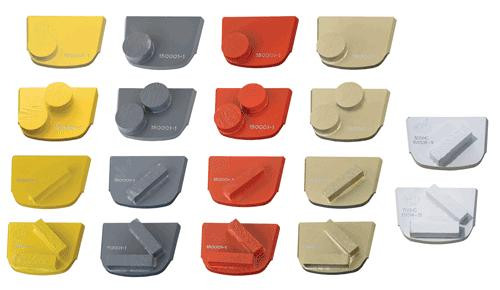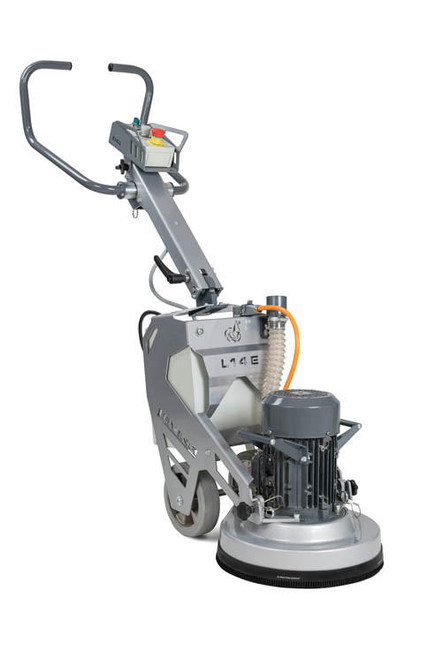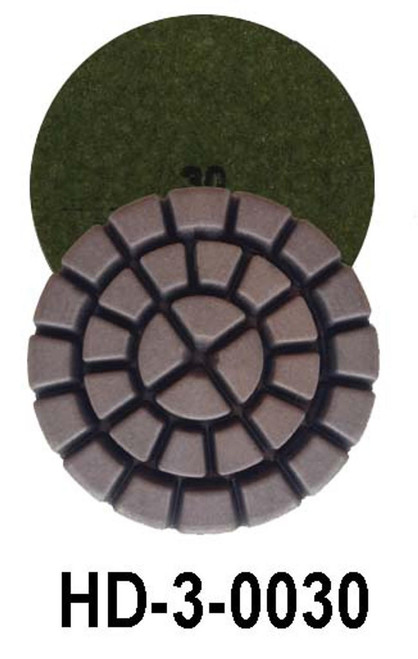Product Description
Our Quick Change diamonds come in different metal bonds designed specifically for the different types of concrete hardness. To select the correct bond for a specific floor, we recommend using the Mohs Scratch Test kit first to determine the hardness of the concrete.
YELLOW BOND SERIES for SOFT CONCRETE, typically under 2500 psi, Mohs Scale 2-3
Grit range: 6,14,30,50,70,120
GRAY BOND SERIES for MEDIUM CONCRETE, between 2500 and 4000 psi, Mohs Scale 3-5
Grit range: 6,14,30,50,70,120
RED BOND SERIES for HARD CONCRETE, between 4000 and 5500 psi, Mohs Scale 5-7
Grit range: 14,30,50,70,120
GOLD BOND SERIES for EXTRA HARD Concrete, over 5500 psi, Mohs Scale 7-8
Grit range: 14,30,50,70,120
WHITE BOND SERIES - our softest bond ever designed for SUPER HARD CONCRETE, over 7000 psi, Mohs Scale 8-9
Grit range: 30,50,70,120
- Choose between one or two segments (buttons or bars) to control the speed and aggressiveness of the cut. Fewer segments cut faster, whereas more segments create more surface contact and allow for surface refinement with less scratches.
- Double button / bar tools are recommended for heavier machines - larger than 25 inches. Single button / bar tools are designed for lighter machines, or where aggressive stock removal is required. We recommend using single-segment tools for the first step even with heavier machines for faster opening of the concrete.
- To expose medium to large aggregate, you can start with 30 grit metals. For small to medium aggregate start with 70 grit metals. For salt and pepper - 120 grit metals.
- Grinders with 13" heads (13, 14, 30, 3213 models) should be loaded with 18 tools, i.e. 6 pieces per head.
DIAMOND GLAZING & PREMATURE WEAR
Grinding very hard or very soft concrete can be challenging, especially if you don't have the right bond tool for the job. For example, soft concrete is very abrasive and will wear out your diamonds faster. You should use a harder bond, so it can last longer. On the other hand, grinding hard concrete requires a soft bond tool to avoid diamond glazing, where tools just don't cut - they slide on teh concrete surface because there is not enough abrasion to keep the diamonds open. It would be best to switch to a softer bond tool but if you don't have that on hand, to open the diamonds, you can add water, i.e. grind wet. You can also try adding an abrasive, such as sand but keep in mind that will wear out the diamonds faster.
Grinding WET OR DRY?
Dry grinding requires less clean up and no slurry disposal. However, it does require the use of a dust collector vacuum. The wet process uses water to cool the diamond abrasives and improve their life, as well as to eliminate grinding dust. The disadvantage is that collecting and disposing of the slurry slows down the process.
Cleaning thoroughly between steps will remove any residual diamond material from the floor and prevent scratching during the next step. For best results during grinding and polishing, we recommend an overlap of about 1/3 of each pass on the floor.





















